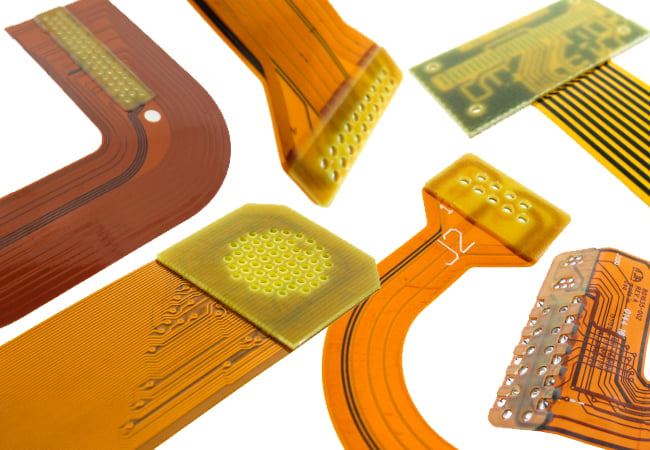Flexible circuit boards are necessary in numerous applications where a design requires the circuit to be bent within the electrical equipment or electronic device. However, it is not desired to have the flexible circuit board bend adjacent to connectors, mounted components, solder joints, and hole patterns. In these instances, a stiffener needs to be designed in to add rigidity and stability so that the flex circuit performs reliably.
Stiffener materials may also be used for other purposes. There may be an area in the design that requires a specified thickness to meet a connector specification when joining with other components. An area on the flexible circuit board may also need to be stiffened to constrain a bend to a specific location based on the application.

Flexible PCBs with various types of stiffeners.
Additionally, working components in the machinery or product may rub against the circuit board and cause excessive wear and tear. Stiffener material can be used to add addition durability and abrasion resistance. Another use for a stiffener is to facilitate handling when installing it into the final assembly, or to provide a heat sink to draw excessive temperatures away from other components.

Main Stiffener Types
When designing a flexible circuit, selecting the right stiffener material is essential as it can provide a range of desired benefits based on the application. Four main stiffener materials used are FR4, Polyimide, Aluminum and Stainless Steel.
FR4
FR4, also referred to as G10, is a woven glass-fiber laminate hardboard with epoxy impregnated into the material. When used for flex circuit boards, the stiffener material typically comes unclad with no copper added. For some applications, copper pads or plated holes may be placed onto the FR4 for component mounting purposes.
FR4 can be bonded using a flex adhesive, that is thermally set, or a with a pressure sensitive adhesive (PSA). Standard thicknesses for FR4 range from 0.008" up to 0.059". When utilizing an FR4 stiffener on a circuit board with a plated-through holes, the stiffener needs to be placed on the same side of the flex as the connector or component to allow for access to the solder pads on the opposing side. On surface-mount technology (SMT) flex circuit boards, the FR4 stiffener needs be placed on the opposite side of the components.
Polyimide
Polyimide is made from a high-temperature polymer crafted into a thin film layer. The film is available in a variety of thickness or multiple layers can be stacked to achieve a greater thickness. Stiffeners made from polyimide can vary from 0.001" up to 0.009", although flexible circuit boards typically require a thickness ranging around 0.005".
Polyimide film stiffeners are attached using a thermal set adhesive. They can be utilized with many types of components and or connectors but are specifically required for zero insertion force (ZIF) connectors. The polyimide stiffener allows the design to meet the necessary thickness level specifications of ZIF connectors.
Stainless Steel
Stainless steel is a stiffener alternative when more rigidity is required than what FR4 can provide. There may be areas on the flex circuit that requires support, yet polyimide and FR4 simply can't provide the necessary strength due to a space limitation that limits the thickness of the stiffener.
Stainless steel can provide the thinness that is required in these areas while providing added stiffness necessary. However, one thing to keep in mind is that stainless steel much more costly than other types of materials.
Aluminum
Aluminum is another alternative to the polymer or glass/epoxy stiffeners commonly used for flexible circuit boards. The main reason that aluminum is used involves applications where a lot of heat may be generated.
To move and dissipate that heat from components, aluminum is added as a stiffener as the metal acts as a heat sink. So, components and connectors can remain cool as the aluminum will draw away the heat. Just like with stainless steel, aluminum will cost more than when using either polyimide or FR4 materials.
Flex PCB Mechanical Design Benefits and Best Options for Stiffeners
Each type of stiffener material provides a range of benefits depending on what the designer requires for their flexible circuit design. Here are some common applications for stiffeners from which a designer can determine which type of material is best suited for the application, take into account cost considerations and determine additional advantages about a specific material.
Supporting Component / Connectors Areas
When it comes to supporting a component or connector area, stiffeners can be manufactured out of Polyimide, FR4, aluminum and stainless-steel materials. When narrowing down the choices, a manufacturer should review other considerations.
When looking for the least expensive material to use in this situation, polyimide or FR4 is the answer. If the engineering is looking for a material to make the circuit board more rigid as well as being used as a carrier panel for assembly purposes, then FR4 is the most common choice.
ZIF Connectors
Only polyimide stiffeners can be used for ZIF connector applications. The stiffener allows for the necessary increased thickness at the connector contacts. The stiffener can only be applied with thermally bonded flex adhesive and is attached prior to profiling the part outline. It is applied oversized to the part outline which then allows the stiffener and the part outline to be cut simultaneously to ensure the tight dimensional tolerances, required by ZIF connector specifications, are achieved.
Additional Thickness and Strength
When there needs to be an increased thickness in a specifc area, polyimide stiffeners are preferred. Polyimide is also ideal when the flexible circuit board will experience higher than normal wear-and-tear.
Thermal Transfer Management
For Flexible circuits that generate excess heat that needs to be dissipated, aluminum stiffeners can be used. Their heat transfer capabilities will allow heat to be transferred from components to the back of the flexible circuit where it can then dissipate into the environment or the device enclosure.
Controlling Bend Locations
In some designs there may be a requirement where the bend locations must be constrained to specific locations. Polyimide is most commonly used but some applications may require FR4. This can allow the circuit to better fit within in the final product or equipment without the risk of becoming damaged or facilitate the assembly process.
Cost Factors
Controlling costs is an important element of a successful flexible circuit design. With respect to cost polyimide is generally the most cost effective. It is easily crafted using a die or laser cutting, making it easier to manufacturer. FR4 is also widely used and cost effective. Its added rigidity creates a flat and stable surface. It does however typically require additional drill and routing operations to manufacture. Aluminum and stainless steel are more costly. The materials themselves are more expensive and they typically require more expensive machining operations. The designer needs to evaluate the flexible circuit design requirements to determine the best stiffener for the job.

Solutions in Flex Circuit Stiffeners
Stiffeners in a flex PCB design add functionality to the finished part. Either when required to rigidize a specific area for component support or to increase the part thickness, in a localized area, to meet a specific connector specification. If you are trying to figure out the best stiffener for your flexible circuit boards, turn to Epec Engineered Technologies. We design and create flex and rigid-flex circuits for your electronic applications.
Key Takeaways
- Purpose of stiffeners: Stiffeners are added to flex circuits where bending is undesirable, such as near connectors, solder joints, or components. They also provide thickness for connector specifications, durability against abrasion, improved handling, and even thermal dissipation.
- FR4 stiffeners: FR4 (G10) is the most common stiffener, offering rigidity and a flat surface. It’s inexpensive, widely used for supporting connectors, and bonded with adhesives, though additional drill/routing steps may increase processing costs.
- Polyimide stiffeners: Polyimide film is thin, cost-effective, and ideal for ZIF connector applications due to its dimensional stability. It can be stacked for thickness, is abrasion-resistant, and is commonly used to constrain bend locations or add localized strength.
- Metal stiffeners: Aluminum stiffeners provide heat dissipation, acting as heat sinks for thermal management, while stainless steel is used in designs where maximum rigidity is needed in thin spaces. Both options are more costly than FR4 or polyimide.
- Cost and application trade-offs: Polyimide and FR4 are the most cost-effective and versatile choices, while aluminum and stainless-steel offer specialized benefits for high-heat or high-strength needs. Designers must balance performance requirements with cost and manufacturability.















